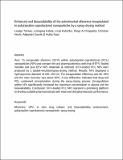| dc.contributor.author | Tshweu, Lesego | |
| dc.contributor.author | Katata, Lebogang | |
| dc.contributor.author | Kalombo, Lonji | |
| dc.contributor.author | Chiappetta, Diego | |
| dc.contributor.author | Hocht, Christian | |
| dc.contributor.author | Sosnik, Alejandro | |
| dc.contributor.author | Swai, Hulda | |
| dc.date.accessioned | 2019-10-16T08:24:47Z | |
| dc.date.available | 2019-10-16T08:24:47Z | |
| dc.date.issued | 2014-10-17 | |
| dc.identifier.issn | 1748-6963 | |
| dc.identifier.other | 24364871 | |
| dc.identifier.uri | https://doi.org/10.2217/nnm.13.167 | |
| dc.identifier.uri | http://dspace.nm-aist.ac.tz/handle/123456789/491 | |
| dc.description | Research Article published by NANOMEDICINEVOL. 9, NO. 12 | en_US |
| dc.description.abstract | Aim: To encapsulate efavirenz (EFV) within poly(epsilon-caprolactone) (PCL) nanoparticles (NPs) and compare the oral pharmacokinetics with that of EFV-loaded micelles and pure EFV NPs. Materials & methods: EFV-loaded PCL NPs were produced by a double-emulsion/spray-drying method. Results: NPs displayed a hydrodynamic diameter of 200–250 nm. The encapsulation efficiency was 86–93% and the mass recovery was above 60%. X-ray diffraction indicated that drug and PCL underwent amorphization during the spray-drying process. Encapsulation within NPs significantly increased the maximum concentration in plasma and the bioavailability. Conclusion: EFV-loaded PCL NPs represent a promising platform to develop scalable pharmaceuticals with improved (bio)pharmaceutic performance. | en_US |
| dc.language.iso | en | en_US |
| dc.publisher | NANOMEDICINE | en_US |
| dc.subject | HIV | en_US |
| dc.subject | Efavirenz | en_US |
| dc.subject | In vitro drug release | en_US |
| dc.subject | Oral bioavailability enhancement | en_US |
| dc.subject | Poly(epsilon-caprolactone) nanoparticle | en_US |
| dc.subject | Spray drying | en_US |
| dc.title | Enhanced oral bioavailability of the antiretroviral efavirenz encapsulated in poly(epsilon-caprolactone) nanoparticles by a spray-drying method. | en_US |
| dc.type | Article | en_US |

